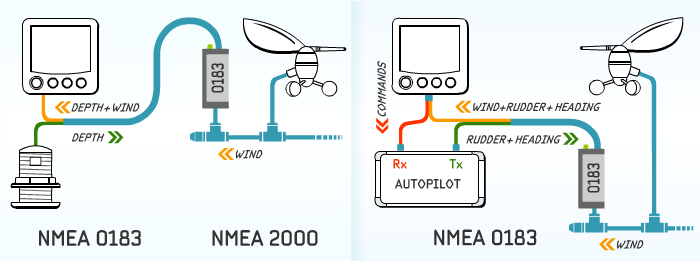The NMEA 0183 interface is a widely adopted communication standard in maritime and other navigation systems. Developed by the National Marine Electronics Association (NMEA), this protocol allows various marine devices to communicate with one another efficiently.
While newer standards such as NMEA 2000 have been introduced, NMEA 0183 remains in use due to its simplicity and compatibility with a vast array of equipment. Let’s explore the key features of NMEA 0183, its applications in maritime systems, and how it contributes to the efficient operation of vessels.

What is NMEA 0183?
NMEA 0183 is a serial communication protocol designed for marine electronics. Its primary purpose is to transmit standardized data between different types of marine devices, such as GPS units, autopilots, depth finders, and AIS (Automatic Identification System) transceivers. One of the most significant advantages of NMEA 0183 is that it allows these devices from different manufacturers to communicate and share information seamlessly.
The protocol uses simple ASCII text to represent various navigation data, such as location coordinates, speed, heading, and depth. Each data set, called a “sentence,” contains a specific message type and a series of parameters.
How NMEA 0183 Works
Wiring
NMEA 0183 uses a single-ended communication setup with a transmitter and receiver. Typically, a pair of wires is used (positive and ground), with communication occurring at 4,800 baud for most applications. However, for certain high-speed devices like AIS, NMEA 0183 operates at 38,400 baud.
Data Transmission
The protocol supports one-way communication (talker-listener). A single device (the talker) can transmit data to multiple listeners. However, listeners cannot transmit back to the talker. This simplicity makes it ideal for straightforward data broadcasting but limits two-way device interaction
Sentence Structure
Each NMEA 0183 sentence begins with a dollar sign ($), followed by a talker identifier, message type, data fields, and ends with a checksum for error checking.
Key Applications in Maritime Systems
GPS Navigation
One of the most common uses of NMEA 0183 is transmitting GPS data. Devices such as chart plotters and GPS receivers rely on this interface to share real-time position data with other navigation instruments on board the vessel.
Autopilot Integration
Autopilots often use NMEA 0183 to receive course data from GPS or compass units. The autopilot system can then maintain the vessel’s heading based on the data provided, ensuring the vessel stays on course.
Depth Sounders and Fishfinders
Depth sounders and fishfinders transmit depth data to other onboard systems using NMEA 0183 sentences. This data can be used to alert the crew if the vessel is approaching shallow waters or to improve the understanding of underwater terrain.
AIS (Automatic Identification System)
AIS transponders utilize the NMEA 0183 interface to send information about a vessel’s identity, position, speed, and course to other nearby vessels and shore stations. This is crucial for collision avoidance and maritime traffic management.

Advantages
Simplicity
The protocol is easy to implement and widely supported by a variety of marine electronics.
Low-cost integration
NMEA 0183 systems are affordable and have a large ecosystem of compatible devices.
Versatility
It supports a range of maritime applications, from basic GPS data sharing to more advanced features like AIS and depth sounding.
Limitations
One-way communication
The talker-listener setup prevents two-way data exchange, meaning listeners cannot send information back to the talker.
Low data rate
At 4,800 baud, the standard NMEA 0183 connection can be slow for modern, data-intensive applications.
Limited connectivity
Each NMEA 0183 device typically has one talker output, so connecting multiple devices can require additional multiplexers.
get the Right Team
Team Vivo has over 10 years of expertise in installing and configuring telecom systems using NMEA 0183.
Despite its limitations and the rise of newer standards, its simplicity, reliability, and compatibility with older devices ensure its continued use in the maritime industry.










